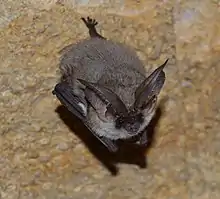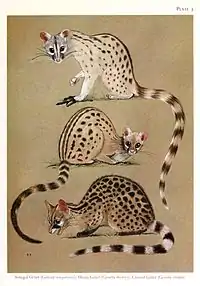Johann Baptist Fischer
Johann Baptist Fischer, born 1803 in Munich (Germany), died 30 May 1832 in Leiden (the Netherlands) was a German naturalist, zoologist and botanist, doctor and surgeon.
Johann Baptist Fischer | |
|---|---|
| Born | 1803 |
| Died | 30 May 1832 |
| Nationality | German |
| Known for | Synopsis Mammalium [1] |
| Scientific career | |
| Fields | Zoologist and botanist |



Biography
Fischer was the son of a Munich schoolmaster, also named Johann Baptist, and his wife Cäcilie Haimerl. His younger brother was Sebastian Fischer, who also became a physician and naturalist spending part of his career in Russia and then Egypt.[2]
J. B. Fisher was the assistant of the botanist Carl Ludwig Blume in the former national herbarium of Brussels. In 1826, he joined an expedition to Java, then a possession of the Dutch East Indies, and participated with Blume in writing the description of the species collected.[3] During the Belgian revolution of September 1830, he helped Philipp Franz von Siebold transferring herbarium specimens from Brussels to Leiden in the Netherlands.[4][5] Johann Baptist Fischer also devoted himself to the study of mammals, and he published in 1830 his Synopsis Mammalium.[1] He died at a young age from septic infection.[2]
Taxonomic descriptions
Johann Baptist Fischer described many species of plants, which were proven to be synonyms, as Agathosma desciscens (J.B.Fisch. 1832)[6] synonym for Agathosma bifida Bartl. & H.L.Wendl., 1824.
In his Synopsis Mammalium,[1] he also described a number of new mammalian species and subspecies.
Rodents
- Akodon azarae (J. Fischer, 1829), named in honor of the Spanish naturalist Félix de Azara[1]
- Geocapromys brownii (J. Fischer, 1829), the Jamaican hutia, named in honor of the Irish naturalist Patrick Browne[1]
- Megalomys desmarestii (J. Fischer, 1829), the muskrat of Martinique, an endemic rodent now extinct, and named in honor of the French zoologist Anselme Gaëtan Desmarest.[1]
Primates
- Trachypithecus johnii (J. Fischer, 1829), the Nilgiri langur, a small monkey native to the south west of the India, named in honor of the missionary CS John.[1][7]
Bats
- Centronycteris maximiliani (J. Fischer, 1829), the hirsute bat, named in honor of the prince Maximilian zu Wied-Neuwied[1]
- Pipistrellus rueppellii (J. Fischer, 1829), the Rüppell's pipistrelle, named in honor of the German naturalist Eduard Rüppell[1]
- Plecotus austriacus (J. Fischer, 1829), the grey long-eared bat.[1]
Carnivores
- Caracal caracal nubica (J. Fischer, 1829), the Nubian caracal[1]
- Genetta genetta senegalensis (J. Fischer, 1829), the Senegalese common genet.[1]
Marsupials
- Echymipera kalubu (J. Fischer, 1829), the common spiny bandicoot, a small marsupial of New Guinea.[1]
References
- Fischer, Johann Baptist (1830). Synopsis Mammalium. Addenda, Emendanda Et Index Ad Synopsis Mammalium (in Latin). Stuttgart: sumtibus J. G. Cotta. pp. 817.
- Matzke-Karasz, Renate; Damkaer, David M. (1 January 2012). "Sebastian Fischer (1806-1871), Bavarian Physician-Naturalist in Egypt and Russia". Journal of Crustacean Biology. 32 (2): 327–333. doi:10.1163/193724011X615497.
- Blume, C. L., Fischer, J. B. 1828. Flora Javae nec non insularum adjacentium. J. Frank, Brüssel. Biodiversity Heritage Library
- Dorr, L.J., Nicolson, D.H. 2008. Taxonomic Literature, A selected guide to botanical publications and collections with dates, commentaries and types. Suppl. VII: F-Frer. A.R.G Gantner Verlag K.G., Ruggell, 469 p. [p.215-216], ISBN 978-3-906166-65-0
- E. M. Binsbergen. "Philipp Franz von Siebold (1796–1866). Wetenschapper in de Oost" [Philipp Franz von Siebold (1796–1866). Scientist in the East] (in Dutch). University of Amsterdam. Archived from the original on 2007-03-28. Retrieved 2018-02-06.
- Fischer, Johann Baptist (1832). "Agathosma desciscens, Species nova, descripta". Bijdragen Tot Natuurkundige Wetenschappen. 7: 22–25 – via Biodiversity Heritage Library.
- John, CS 1795. Beschreibung einiger Affen aus Kasi im nördlichen Bengalen, vom Missionary John zu Trankenbar. Neue Schriften, Gesellschaft Naturforschender Freunde zu Berlin 1: 211-218
- IPNI. J.B.Fisch.
- "The Code Online". International Commission of Zoological Nomenclature.